Google’s Anywhere School 2022 event launched a number of products aimed at primary and secondary schools which already use a lot of Chromebooks in their classroom, and since Google’s education push has been fairly successful over the past decade, there are quite a lot of schools in that boat. Let’s take a look at what they announced.
Native Screencasting
Chrome OS now has the ability to natively capture the screen of any computer that it’s its running on. This is already a feature on macOS (shift + command + 5) and Windows 10 and 11 (Windows + alt + R) but this more user friendly version comes with some key features. It automatically captures the front facing camera, something that I had to jerry-rig on a mac by having a zoom window permanently on top while doing the recording. It will also automatically transcribe the audio it hears, increasing accessibility by leveraging google’s ability to transcribe audio better than any other speech to text system on the market, and allow for some basic trimming and editing once the full video is recorded.
Adaptive Practice Sets
Google is introducing native practice sets in Google Classroom and is using (what seems to be fairly limited) AI to adapt the problem sets with the goal of improving student learning. This has to be something that Quizlet is watching with a bit of dread. If you are familiar with Justin Reich’s categories, this is clearly the second type, algorithmic guided learning at scale.
Moderated Casting
Casting is already just about the most consistent in person “screen sharing” product, and allowing teachers to moderate the student casting, and especially to turn off the casting with a single button press, could go a long way to teachers being more willing to try out these uses in their classrooms. Of the four main products showcased here, this is the only one which is positioned primarily for in person interaction.
Figma for Chromebooks
All US high schools can now get access to Figma’s public beta. Figma has been described as “Google docs for design”, something that allows users to change, remix, and make images collaboratively. It seems like the company is exploring exactly where it will provide the most benefit within a school before it can streamline parts of their product and launch paid education tiers.
In general, this is a list of iterative products, but it could lead to some interesting big changes. I am going to keep an eye on the problem sets to see how companies like Quizlet respond and keep an eye on Figma and whether that allows for modes of learning we haven’t seen yet.
More Stories
A Boomer’s view of Student Debt
Student loan forgiveness has been in the news again recently with the White House announcing $5.8b additional student loan debt...
Tutoring as a part of teaching / Everything comes back to money
One of the difficult things with education is our reliance on a “one size fits all” model. We have for...
Justin Reich on Learning Loss, Subtraction in Action, and a future with much more disrupted schooling
Justin Reich is an education and technology researcher and the director of MIT’s Teaching Systems Lab. He hosts a podcast...
Public K-12 Enrollment is falling and that is dangerous and exciting
A surprising result of COVID and the resulting school closures is that many parents, after struggling to figure out how...
Esports could help re-diversify a shrunken curriculum
Esports and schools feel like a pretty strange fit. Regular sports have always gone with schools, but adding esports still...
People aren’t flipping out for flipped classrooms like they used to
Flipped learning, a new strategy for teaching that flips the traditional idea of classroom lecture followed by homework on its...
